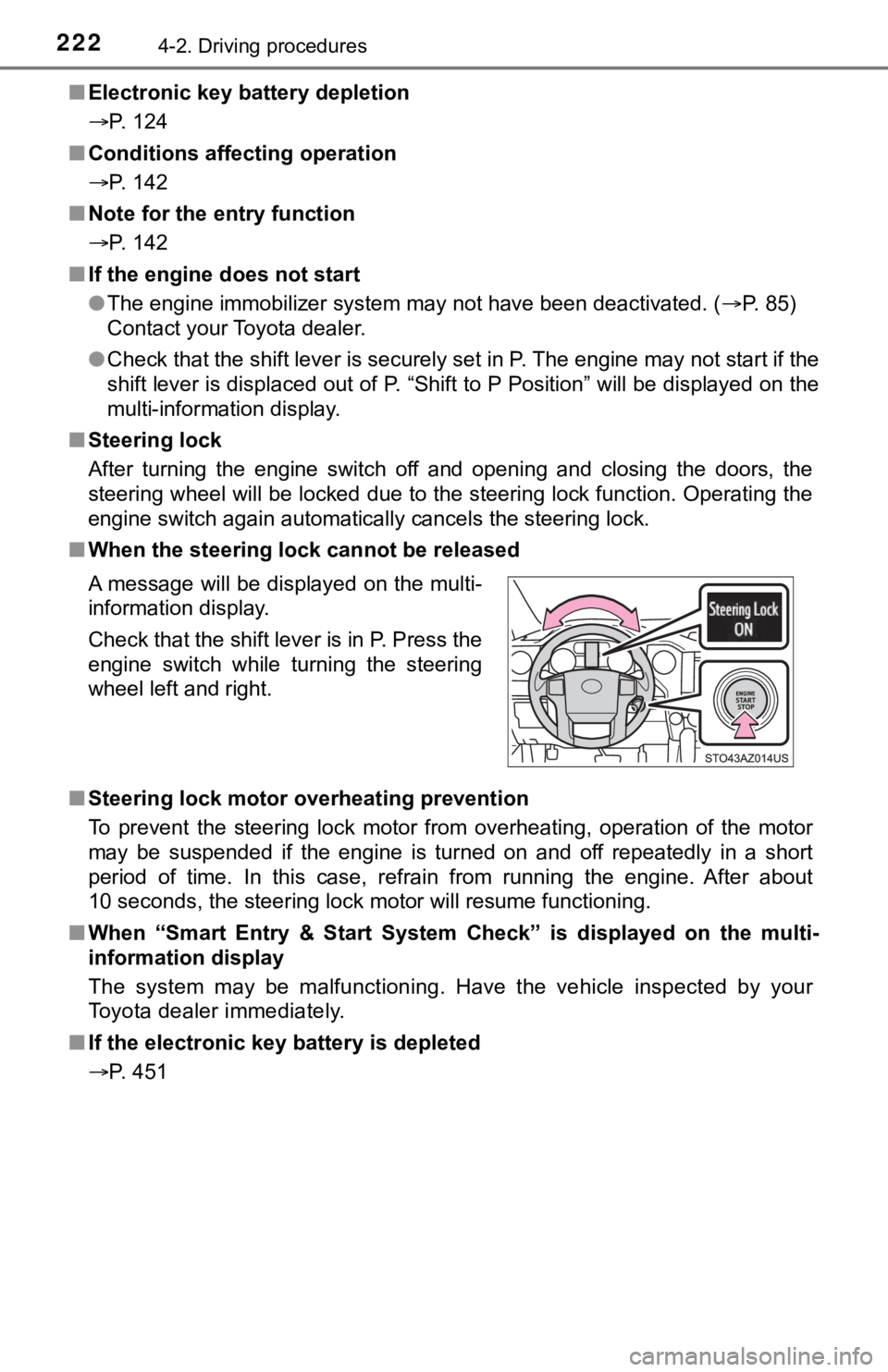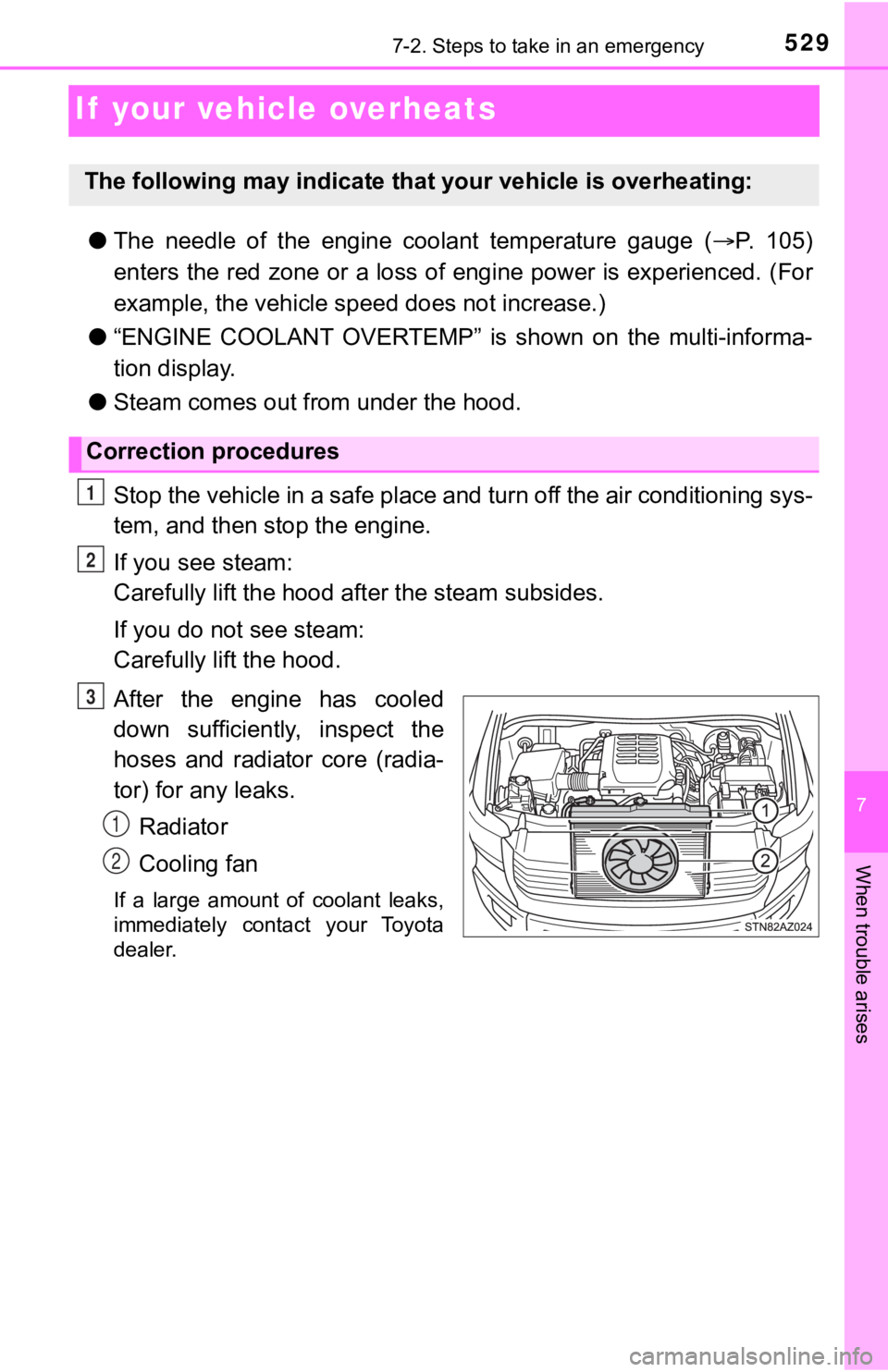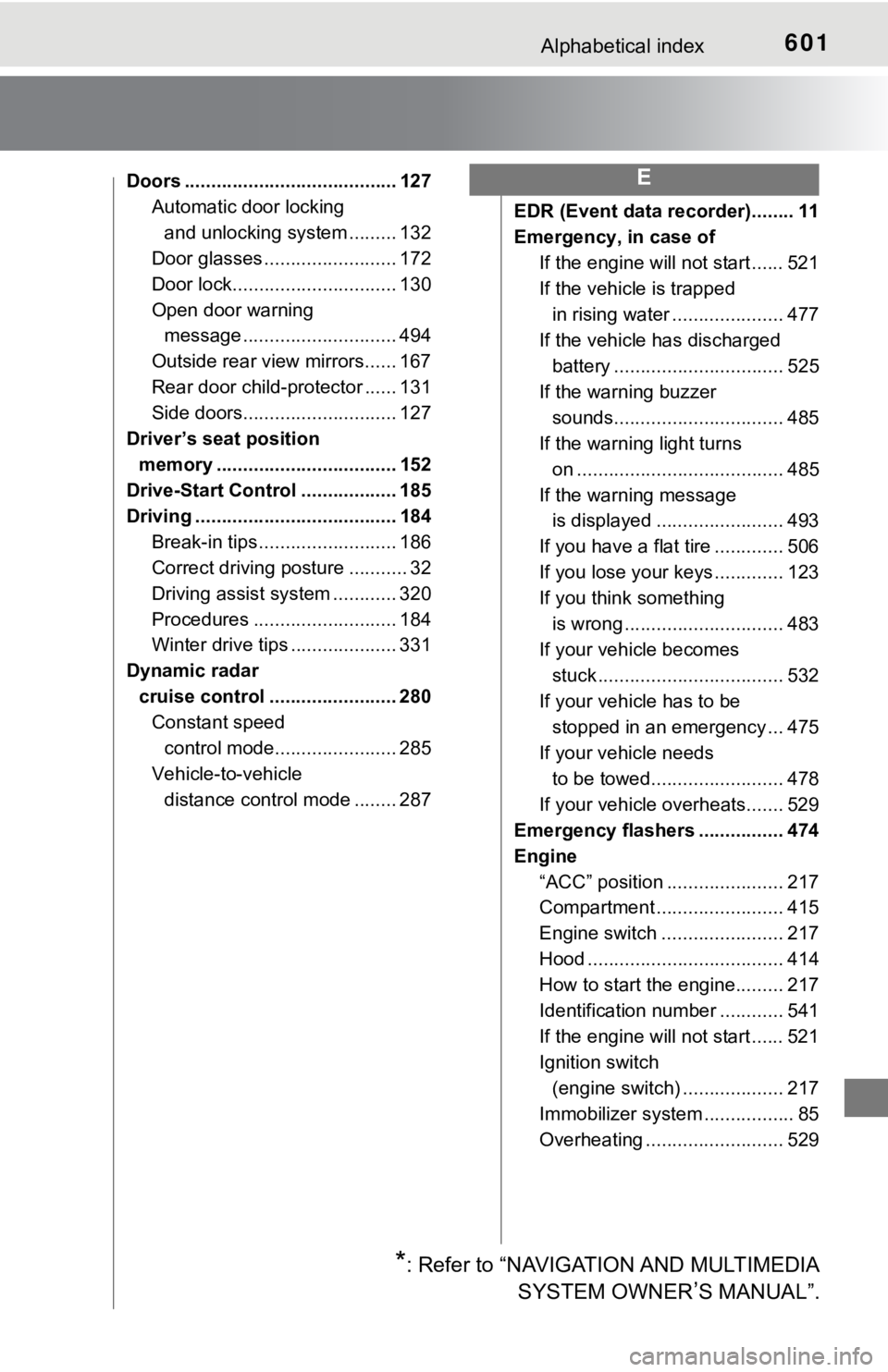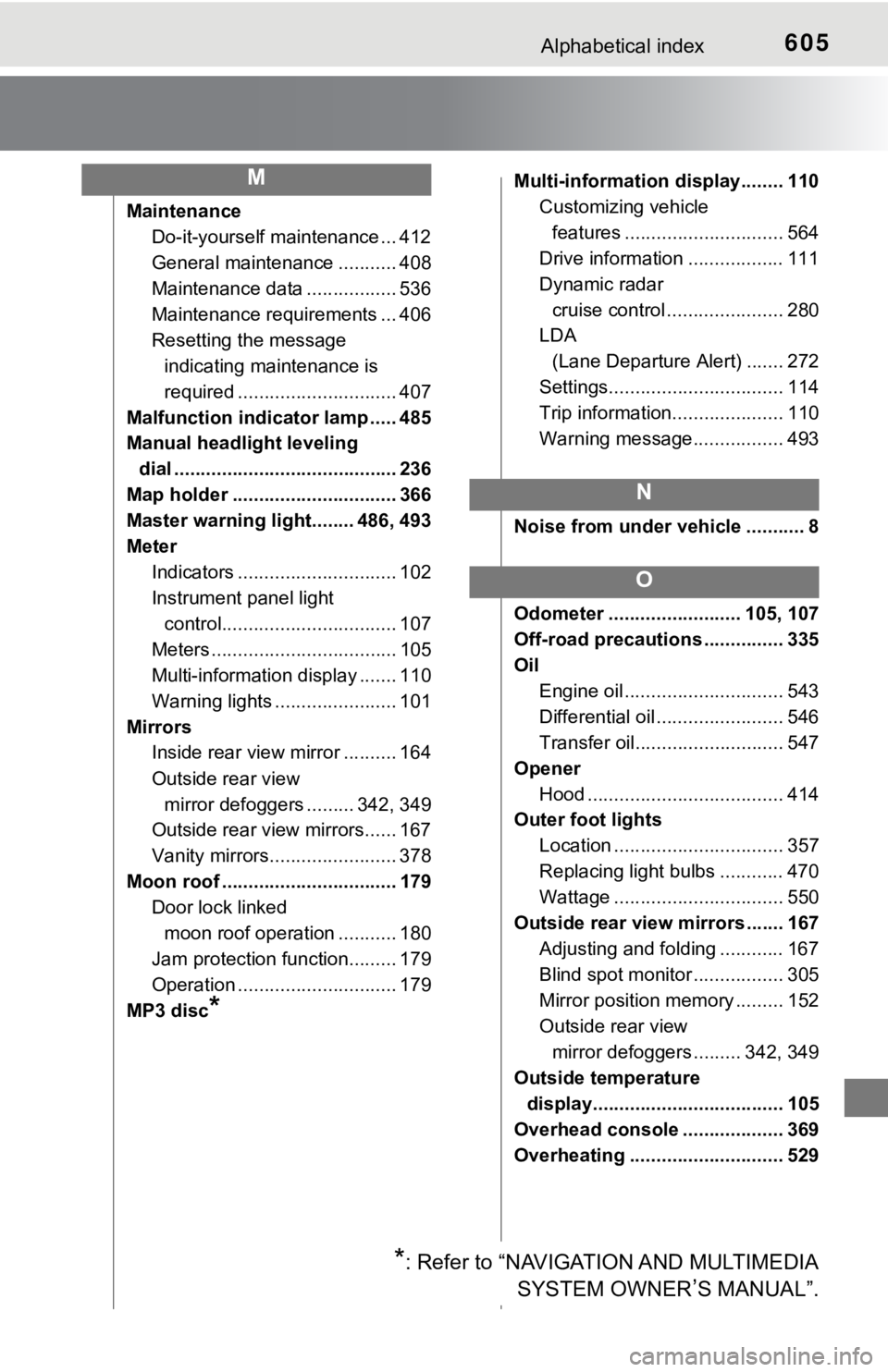overheating TOYOTA TUNDRA 2021 Owners Manual (in English)
[x] Cancel search | Manufacturer: TOYOTA, Model Year: 2021, Model line: TUNDRA, Model: TOYOTA TUNDRA 2021Pages: 612, PDF Size: 13.7 MB
Page 109 of 612

1092. Instrument cluster
2
Instrument cluster
NOTICE
■To prevent damage to the engine and its components
● Do not let the indicator needle of the tachometer enter the red zone, which
indicates the maximum engine speed.
● The engine may be overheating if the engine coolant temperature gauge is
in the red zone (H). In this case, immediately stop the vehicle in a safe
place, and check the engine after it has cooled completely. ( P. 5 2 9 )
■ Vo l t m e t e r
When the voltmeter indicates 19 V or higher or 9 V or lower whi le the engine
is running, there may be a battery or charging system malfunction. Have the
vehicle inspected at your Toyota dealer.
■ Engine oil pressure gauge
When the value of the engine oil pressure gauge drops while the engine is
running, stop the vehicle in a safe place immediately and check the amount
of engine oil. ( P. 416)
When the oil pressure drops even though the engine oil amount h as not
decreased, or if the oil pressure does not increase when engine oil is
added, contact your Toyota dealer, as there may be a problem wi th the lubri-
cation system.
Page 190 of 612

1904-1. Before driving
WARNING
●Do not leave a door or window open if the curved glass is coate d with a
metallized film such as a silver-colored one. Reflected sunligh t may cause
the glass to act as a lens, causing a fire.
● Always apply the parking brake, shift the shift lever to P, stop the engine
and lock the vehicle.
Do not leave the vehicle unattended while the engine is running .
If the vehicle is parked with the shift lever in P but the park ing brake is not
set, the vehicle may start to move, possibly leading to an acci dent.
● Do not touch the exhaust pipes while the engine is running or i mmediately
after turning the engine off.
Doing so may cause burns.
● 4WD models: If the shift lever is moved before the “4LO” indicator turns
on/off, the transfer mode may not be shifted completely. The tr ansfer mode
disengages both the front and rear driveshafts from the powertrain and
allows the vehicle to move regardless of the shift position. (A t this time, the
indicator blinks and the buzzer sounds.)
Therefore, the vehicle is free to roll even if the automatic transmission is in
P. You or someone else could be seriously injured. You must complete the
shifting of the transfer mode. ( P. 315)
■ When taking a nap in the vehicle
Always turn the engine off. Otherwise, if you accidentally move the shift
lever or depress the accelerator pedal, this could cause an acc ident or fire
due to engine overheating. Additionally, if the vehicle is park ed in a poorly
ventilated area, exhaust gases may collect and enter the vehicl e, leading to
death or a serious health hazard.
■ When braking
● When the brakes are wet, drive more cautiously.
Braking distance increases when the brakes are wet, and this ma y cause
one side of the vehicle to brake differently than the other sid e. Also, the
parking brake may not securely hold the vehicle.
● If the brake booster device does not operate, do not follow oth er vehicles
closely and avoid hills or shar p turns that require braking.
In this case, braking is still possible, but the brake pedal sh ould be
depressed more firmly than usual. Also, the braking distance wi ll increase.
Have your brakes fixed immediately.
● Do not pump the brake pedal if the engine stalls.
Each push on the brake pedal uses up the reserve for the power-assisted
brakes.
● The brake system consists of 2 individual hydraulic systems; if one of the
systems fails, the other will still operate. In this case, the brake pedal
should be depressed more firmly than usual and the braking dist ance will
increase. Have your brakes fixed immediately.
Page 210 of 612

2104-1. Before driving
●Avoid sudden braking as you may skid, resulting in the trailer jack-
knifing and a loss of vehicle control. This is especially true on wet or
slippery surfaces.
● Avoid jerky starts or sudden acceleration.
● Avoid jerky steering and sharp turns, and slow down before maki ng
a turn.
● Note that when making a turn, the trailer wheels will be closer than
the vehicle wheels to the inside of the turn. Compensate by mak ing
a wider than normal turning radius.
● Slow down before making a turn, in crosswinds, on wet or slippe ry
surfaces, etc.
Increasing vehicle speed can destabilize the trailer.
● Take care when passing other vehicles. Passing requires consider-
able distance. After passing a vehicle, do not forget the lengt h of
your trailer, and be sure you have plenty of room before changi ng
lanes.
● To maintain engine braking efficiency and charging system perfo r-
mance when using engine braking, do not use the transmission in
D.
Transmission shift ra nge position must be in 4 in the S mode.
● Instability happens more frequently when descending steep or lo ng
downhill grades. Before descending, slow down and downshift. Do
not make sudden downshifts while descending steep or long down-
hill grades.
● Avoid holding the brake pedal down too long or applying the bra kes
too frequently. This could cause the brakes to overheat and result in
reduced braking efficiency.
● Due to the added load of the trailer, your vehicle’s engine may over-
heat on hot days (at temperatures over 85°F [30°C]) when drivin g
up a long or steep grade. If the engine coolant temperature gau ge
indicates overheating, immediately turn off the air conditionin g (if in
use), pull your vehicle off the road and stop in a safe spot.
( P. 529)
Page 222 of 612

2224-2. Driving procedures
■Electronic key battery depletion
P. 124
■ Conditions affecting operation
P. 142
■ Note for the entry function
P. 142
■ If the engine does not start
●The engine immobilizer system may not have been deactivated. ( P. 85)
Contact your Toyota dealer.
● Check that the shift lever is securely set in P. The engine may not start if the
shift lever is displaced out of P. “Shift to P Position” will b e displayed on the
multi-information display.
■ Steering lock
After turning the engine switch off and opening and closing the doors, the
steering wheel will be locked due to the steering lock function . Operating the
engine switch again automatically cancels the steering lock.
■ When the steering lock cannot be released
■ Steering lock motor overheating prevention
To prevent the steering lock motor from overheating, operation of the motor
may be suspended if the engine is turned on and off repeatedly in a short
period of time. In this case, refrain from running the engine. After about
10 seconds, the steering lock motor will resume functioning.
■ When “Smart Entry & Start System Check” is displayed on the multi-
information display
The system may be malfunctioning. Have the vehicle inspected by your
Toyota dealer immediately.
■ If the electronic key battery is depleted
P. 451 A message will be displayed on the multi-
information display.
Check that the shift lever is in P. Press the
engine switch while turning the steering
wheel left and right.
Page 233 of 612

2334-2. Driving procedures
4
Driving
Parking brake
To set the parking brake, fully
depress the parking brake pedal
with your left foot while depress-
ing the brake pedal with your right
foot.
(Depressing the pedal again
releases the parking brake.)
■Parking the vehicle
P. 184
■ Usage in winter time
P. 332
U.S.A. Canada
NOTICE
■
Before driving
Fully release the parking brake.
Driving the vehicle with the parking brake set will lead to bra ke components
overheating, which may affect braking performance and increase brake
wear.
Page 355 of 612

3555-1. Using the air conditioning system
5
Interior features
■Seat ventilators
Blows air from the seat Hi
Mid
Lo
Off
The level indicator lights come on.
Pressing the button changes
modes in the following:
HiMid LoOff
■The seat heaters/seat ventilators can be used when
The engine switch is in ON.
■ Passenger seat ventilator timer (vehicles with seat ventilators )
● The ventilator operates on for 5 minutes after the button is pr essed.
● When the passenger is not detected, the automatically turns off the ventila-
tor after 5 minutes.
■ When not in use
Turn the seat heaters or seat ventilators off by pressing the b utton. The indi-
cator light turns off.
1
2
3
4
WARNING
■ Burns
● Use caution when seating the following persons in a seat with t he seat
heater on to avoid the possibility of burns:
• Babies, small children, the elderly, the sick and the physical ly chal-
lenged
• Persons with sensitive skin
• Persons who are fatigued
• Persons who have taken alcohol or drugs that induce sleep (sle eping
drugs, cold remedies, etc.)
● Do not cover the seat with anything when using the seat heater.
Using the seat heater with a blanket or cushion increases the t emperature
of the seat and may lead to overheating.
● Do not use seat heater more than necessary. Doing so may cause minor
burns or overheating.
Page 529 of 612

529
7
When trouble arises
7-2. Steps to take in an emergency
If your vehicle overheats
●The needle of the engine coolant temperature gauge ( P. 1 0 5 )
enters the red zone or a loss of engine power is experienced. ( For
example, the vehicle speed does not increase.)
● “ENGINE COOLANT OVERTEMP” is shown on the multi-informa-
tion display.
● Steam comes out f rom under the hood.
Stop the vehicle in a safe place and turn off the air condition ing sys-
tem, and then stop the engine.
If you see steam:
Carefully lift the hood after the steam subsides.
If you do not see steam:
Carefully lift the hood.
After the engine has cooled
down sufficiently, inspect the
hoses and radiator core (radia-
tor) for any leaks. Radiator
Cooling fan
If a large amount of coolant leaks,
immediately contact your Toyota
dealer.
The following may indicate that your vehicle is overheating:
Correction procedures
1
2
3
1
2
Page 600 of 612

600Alphabetical index
Child safety ................................ 58Airbag precautions .................. 44
Battery precautions ............... 527
Child restraint system ............. 59
How your child should wear the seat belt ................. 36
Installing child restraints ......... 63
Moon roof precautions .......... 182
Power back window precautions ......................... 178
Power window lock switch .... 172
Power window precautions ... 174
Rear door child-protector ...... 131
Removed wireless remote control battery
precautions ......................... 453
Seat belt extender precautions ........................... 39
Seat belt precautions .............. 62
Seat heater precautions........ 355
Child-protectors....................... 131
Cleaning ........................... 400, 403 Aluminum wheels.................. 400
Exterior ................................. 400
Interior................................... 403
Seat belts .............................. 404
Clock
*
Compass .................................. 394
Condenser ................................ 420
Console box ............................. 363
Coolant ..................................... 418 Capacity ................................ 545
Checking ............................... 418
Preparing and checking before winter....................... 331
Cooling system ........................ 418 Engine overheating ............... 529
CRS ............................................. 59 Cruise control
Cruise control ....................... 294
Dynamic radar cruise control ...................... 280
Cup holders ............................. 370
Curtain shield airbags............... 41
Customizable features ............ 564
Daytime running light system.................................... 237
Deck hooks .............................. 377
Defogger Back window................. 342, 349
Outside rear view mirrors ........................ 342, 349
Windshield .................... 342, 349
Differential................................ 546
Dimensions .............................. 536
Dinghy towing.......................... 216
Display Drive information .................. 111
Dynamic radar
cruise control ...................... 280
LDA
(Lane Departure Alert) ....... 272
Multi-information display ....... 110
Trip information..................... 110
Warning message................. 493
Do-it-yourself maintenance .... 412
Door lock .................................. 127 Doors .................................... 127
Key ....................................... 127
Smart key system ................. 128
Wireless remote control ........ 128
D
Page 601 of 612

601Alphabetical index
Doors ........................................ 127Automatic door locking and unlocking system ......... 132
Door glasses ......................... 172
Door lock............................... 130
Open door warning message ............................. 494
Outside rear view mirrors...... 167
Rear door child-protector ...... 131
Side doors............................. 127
Driver’s seat position memory .................................. 152
Drive-Start Control .................. 185
Driving ...................................... 184
Break-in tips .......................... 186
Correct driving posture ........... 32
Driving assist system ............ 320
Procedures ........................... 184
Winter drive tips .................... 331
Dynamic radar cruise control ........................ 280 Constant speed
control mode....................... 285
Vehicle-to-vehicle distance control mode ........ 287 EDR (Event data recorder)........ 11
Emergency, in case of
If the engine will not start ...... 521
If the vehicle is trappedin rising water ..................... 477
If the vehicle has discharged battery ................................ 525
If the warning buzzer sounds................................ 485
If the warning light turns
on ....................................... 485
If the warning message is displayed ........................ 493
If you have a flat tire ............. 506
If you lose your keys ............. 123
If you think something is wrong .............................. 483
If your vehicle becomes stuck ................................... 532
If your vehicle has to be stopped in an emergency ... 475
If your vehicle needs
to be towed......................... 478
If your vehicle overheats....... 529
Emergency flashers ................ 474
Engine
“ACC” position ...................... 217
Compartment ........................ 415
Engine switch ....................... 217
Hood ..................................... 414
How to start the engine......... 217
Identification number ............ 541
If the engine will not start ...... 521
Ignition switch (engine switch) ................... 217
Immobilizer system .. ............... 85
Overheating .......................... 529E
*: Refer to “NAVIGATION AND MULTIMEDIA SYSTEM OWNER
’S MANUAL”.
Page 605 of 612

605Alphabetical index
MaintenanceDo-it-yourself maintenance ... 412
General maintenance ........... 408
Maintenance data ................. 536
Maintenance requirements ... 406
Resetting the message indicating maintenance is
required .............................. 407
Malfunction indicator lamp ..... 485
Manual headlight leveling dial .......................................... 236
Map holder ............................... 366
Master warning light........ 486, 493
Meter Indicators .............................. 102
Instrument panel light control................................. 107
Meters ................................... 105
Multi-information display ....... 110
Warning lights ....................... 101
Mirrors Inside rear view mirror .......... 164
Outside rear view
mirror defoggers ......... 342, 349
Outside rear view mirrors...... 167
Vanity mirrors........................ 378
Moon roof ................................. 179 Door lock linked
moon roof operation ........... 180
Jam protection function......... 179
Operation .............................. 179
MP3 disc
*
Multi-information display........ 110 Customizing vehicle features .............................. 564
Drive information .................. 111
Dynamic radar cruise control ...................... 280
LDA
(Lane Departure Alert) ....... 272
Settings................................. 114
Trip information..................... 110
Warning message................. 493
Noise from under vehicle ........... 8
Odometer ......................... 105, 107
Off-road precaution s ............... 335
Oil
Engine oil .............................. 543
Differential oil ........................ 546
Transfer oil............................ 547
Opener Hood ..................................... 414
Outer foot lights
Location ................................ 357
Replacing light bulbs ............ 470
Wattage ................................ 550
Outside rear view mirrors ....... 167 Adjusting and folding ............ 167
Blind spot monitor ................. 305
Mirror position memory ......... 152
Outside rear view mirror defoggers ......... 342, 349
Outside temperature display.................................... 105
Overhead console ................... 369
Overheating ............................. 529M
N
O
*: Refer to “NAVIGATION AND MULTIMEDIA SYSTEM OWNER
’S MANUAL”.